|
EQUINE CLICKER TRAINING..... using precision and positive reinforcement to teach horses and people |
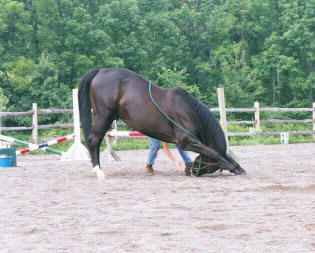
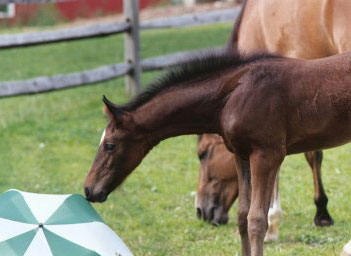
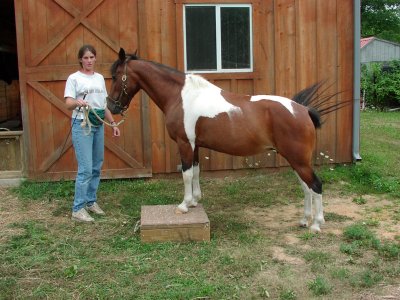
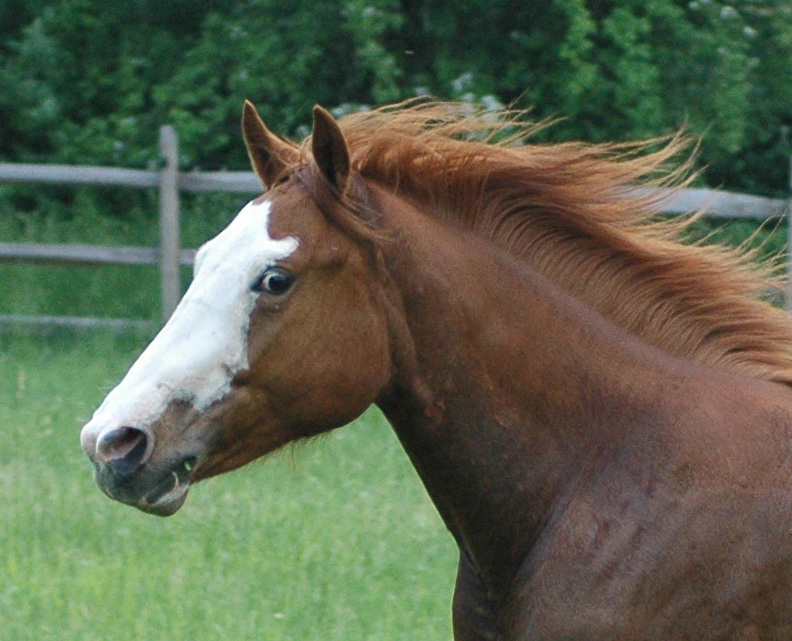
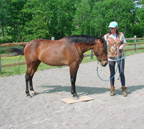
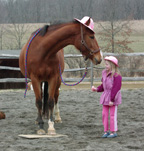
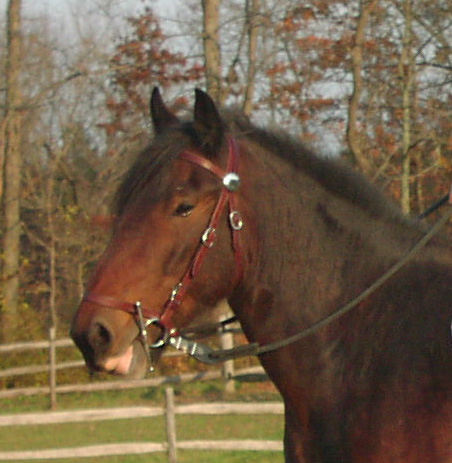
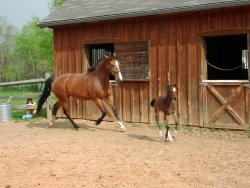 |
|
Read through this section and then proceed to exercise 1 which is done
without the horse. I have put the information about the first horse
session here so that you are familiar with it when you do the without horse
exercise.
There are many layers to targeting. The first lesson for the horse is usually the
simplest one, which is teaching the horse to touch an object with its nose.
Further down the line, I can improve the “quality” of
my horse’s targeting by only reinforcing for touching the object with closed
mouth and adding in such things as duration, distance, targeting novel
objects, targeting with other body parts, following a target and other more
advanced uses for targeting.
Equipment
1.
your horse behind protective contact such as behind a fence, gate,
stall guard etc… because most horses have to go through a learning process
about space and food. These early lessons are important so make sure
you set it up so that the horse does not start off by making mistakes or
creating bad habits.
2.
target (a target can be anything, but first targeting sessions go
better if you use something that can be held out away from your body and I
like to use a target that has a clearly defined area for touching, such as a
ball on a stick or something attached to the end of a whip). I like to
use an object that I don’t use for anything else for the initial targeting.
That way the horse doesn’t offer targeting unless I specifically want it.
3.
clicker (I use a mechanical clicker to start, a tongue click later
on)
4.
reinforcement such as small pieces of carrots, grain, horse
treats, hay stretchers, etc…. You want many small treats and you want them
in a location where you can easily reach them. I use a vest or waist
pack or the pockets of my coat if I am wearing one. Training Scenario for First Lesson
Now that you are organized and ready to go, here are the actual
steps to teach targeting.
1.
Present the target by extending your arm out away from you and
toward the horse’s nose.
2.
Click
3.
Put the target behind you
4.
Get the treat and feed out away from your body
5.
Present the target (horse can still be eating)
When you work with your horse, you are going to follow these steps and do
several repetitions before taking a break. Horses learn better when
you do several short sessions so I often count out 10-20 treats and do that
many repetitions before taking a break. A break could be as simple as
going away for a few minutes or doing something else with the horse.
If the horse is engaged and enjoying the game, make sure you end each
little session nicely so the horse doesn’t feel frustrated that you are
leaving or ending the game. I often put a handful of goodies in the horse’s
bucket or feed extra for the last effort and make a big fuss before going
off to do something else.
One additional suggestion I would make is that if you can find someone to
help you, practice targeting with a person before you go out and do it with
a horse. It may seem silly but it actually takes a bit of coordination
to teach targeting with clear and consistent body movements. If you
can’t get a friend to help, you can practice on your own, choosing an item
to touch and putting food in a container.
-Tips on presenting the target:
Most horses are curious and will orient toward the
target so the first click or two is easy. Then once the horse realizes you
have food, you may become more interesting than the target. This is one
reason to present the target out away from your body. It makes it clearer to
the horse that touching you does not earn reinforcement.
When I first start, I try to present the target in the
same location until the horse is consistently touching it with no extra
behaviors such as mugging me or responding to any distractions. I usually
stand slightly to the side and present the target so it is right in front of
the horse.
What I like to do is present the target in the easiest place for the horse
to reach, usually right in front of him and feed in the same location. I am
actually teaching the horse to keep his head within a certain zone as that
is the area in which the target is presented and also the area in which he
is fed. This creates a zone of reinforcement out away from me and helps to
avoid some of the unwanted behavior chains that can occur in early training
sessions. These chains often involve the horse mugging you for treats
in the gaps between targeting and feeding or feeding and the presentation of
the target again. At this point, I don’t want the horse looking
for the target in different locations, I want the horse learning to wait for
the target so he can touch it and then wait for his food.
-Tips for getting the horse started and what to click:
Click for any movement toward the target. In early targeting sessions you
want to get the horse’s attention and get him engaged in the game so you
want to make it easy enough for the horse to earn some reinforcement, but be
careful that you also give the horse some time to think. I may “help” a
horse a bit and then become more passive and see if the horse will take some
initiative. To “help” the horse, I might present the target again
(horses react to movement), wiggle the target gently, or put it where the
horse might “accidentally” bump into it.
For example, if I have a horse that keep getting distracted by something to
its right, I will position the target so the horse encounters it as it turns
to look at the distraction There are lots of variables you can play
with here such as how far the target is from the nose when you present it.
If the horse is really not getting it, try a different target, or move to a
different location. You might try using a different type of food as a
reinforcer to find something the horse likes better. Some horses will
react to the sound of the clicker by startling. Usually this passes
quickly but if you think the horse is uncomfortable with the sound of the
clicker, you can muffle it by putting it in your pocket or wrapping it with
tape or something else to muffle it. Different clickers make different
sounds. Box clickers tend to be the loudest although their intensity
can vary. The i-click which is Karen Pryor’s clicker with the raised
button is quieter.
I usually start a new horse with a mechanical clicker of some kind. Once the
horse is doing well, I will switch to a tongue click which is the noise you
can make with the tongue on the roof of your mouth. It should be a
clear and distinct sound, not like the clucking and giddy-up sounds we tend
to make with horses. The advantage to the tongue click is that it is
always with you and it gives you one less thing to juggle when you are using
lead ropes or targets.
-Tips on removing the target:
I usually just tuck the target behind my back. You can
put it down out of reach if you are running out of hands, but it is better
if the horse can’t see it.
Why do we remove the target? In the beginning stages, it is not uncommon for
the horse to continue to interact with the target even after I have clicked.
I don’t want the horse to get frustrated because it is touching the target
repeatedly after I have clicked and nothing is happening. So I remove
the target while I get the reinforcement out. This is a clear
indicator to the horse that the food delivery process is starting and I find
it helps many horses learn to do clean target touches. Remember part
of the goal here is to get the horse used to the idea of
behavior->click->reinforce and I want to help the horse understand that the
click tells the horse to stop his behavior and orient to the handler for
reinforcement.
I have also found that if the horse continues to interact with the target
while I am getting the food out, he will experiment with and then abandon
some of the behaviors that can later be used to build duration or teach the
horse to pick the item up. Even though I want the horse offering behavior,
I can use the presentation and removal of the target to start setting the
pace of training. In most training sessions, there ends up being a nice
rhythm where the horse and handler are working at a comfortable pace.
The horse is not rushing the handler through food delivery or to present
the target so the handler is working calmly and smoothly. At the same
time, the handler is monitoring what the horse needs and is not rushing the
horse to offer behavior or take the food. I think removing the target
is part of this process because it helps identify the behavior and the start
of the food delivery cycle.
-Food delivery:
In clicker training, food
delivery is the name we use to refer to the process of getting the
reinforcement from its initial location to the animal. This includes
my body movement as I get the food, and the delivery of the food to the
animal. With horses, hand feeding is usually the most efficient
way to feed them. With horses that are not used to hand feeding, this
skill can be practiced on its own, or it can be taught through clicker
training. If hand feeding is not an option, the food can be placed in
a bucket located near the horse or that is presented to the horse after the
click.
However you choose to deliver the food, this should happen in a predictable
way so that the animal can see that you are getting the reinforcement and
the animal knows where to get the reinforcement. There is an article on my
web site called “Loopy Training” which explains more about the importance of
every step in the behavior->click-reinforcement cycle. What you
need to know now is that the more consistent you are about how you get the
food and present it, the more smoothly these early lessons will go.
Some key points are:
Have the food in an easily accessible location (open pocket on vest, coat,
fanny pack, bucket right next to you, etc…) Having food in Ziploc bags
or in pockets that take time to access will slow you down. With a more
experienced horse, a delay between click and treat might not cause a problem
but with a novice clicker horse, it is important for food delivery to be
prompt and efficient. I do not preload my hand as I think this
distracts the horse and I want the horse to listen for the click, not watch
hand movements. The click takes on value through classical
conditioning* which works best if the two events (click and reinforcement)
happen in sequence with just a slight delay.
I present the food out away from my body in a natural position for the
horse. I don’t want the horse to have to put his head in an awkward position
in order to eat. Food delivery can also be used to set the horse up for
the next trial or to reinforce a particular behavior. Once I have done
some basic targeting, I can experiment with where I deliver the food to see
if a different location improves my horse’s behavior. One common
strategy is to present the food so that the horse has to back up slightly.
Targeting often brings many horses forward and they will end up crowding the
handler or leaning over the stall or gate. By feeding back toward the chest,
you can encourage the horse to back up before you present the target again.
You want to be careful that however you deliver the food, you don’t tease
or lure the horse. Usually changing the feeding location just a few
inches in the desired direction each time is enough to create a shift within
a session. The horse has earned his reinforcement when you click,
don’t make him do extra work.
If I am targeting and asking the horse to touch the target in a difficult
location, I might sometimes feed in the same location as where I presented
the target so the horse is more comfortable being there. This doesn’t mean
asking the horse to contort itself and then feeding there, a more typical
example would be working on targeting a low object when a horse is tense.
The horse might be reluctant to drop his head down and target. I will feed
back at a normal position a few times but then I might start feeding a bit
lower to see if I can reinforce the idea that a lower position is a good
thing. Food delivery and eating are a break for the horse so I
don’t want to make them hard or uncomfortable for the horse, but if I can
gently expand my horse’s comfort zone through the food placement, I will.
Remember, food is a primary reinforce* and what the horse is doing when he
gets his food is being reinforced too.
-Present the target again:
Once I have delivered the food, I will present the target again.
There is often a question of whether or not to present the target if the
horse is still chewing. I think this varies from horse to horse.
I want to present the target at a time when the horse is likely to touch it.
Some horses will be eager to go again while they are still chewing and
I don’t want to frustrate these horses by making them wait. Other horses
need processing time and I don’t want to present the target if they are
going to ignore it.
You are going to repeat these steps, presenting the target in an easy
location until the horse clearly gets that it can get you to click by
touching the target or until you have done enough repetitions that it is
time for a break. Don’t worry if you stop while the horse still seems
confused. Taking a break is helpful for both of you and you don’t have
to worry about ending on a good note.
-Between Sessions: Taking a Break and Ending the
Session
I noted earlier that horses learn better in short sessions so you want to do
a bit of targeting and then take a break. This gives the horse time to
process and think and you should take the time to do the same thing. When I
take a break between sessions, I do end each session in the same way so the
horse gets used to the routine of short sessions . Even at this early
stage, I want to end each mini session on a nice note so I will do the last
target, click, and feed, pat the horse and tell him how brilliant he is, and
walk out of sight or close his door or in some other way, clearly show I am
unavailable for a few minutes. If the horse is in a stall and has a feed bin
that I can access, I will drop a few goodies in the feed bin and then leave.
Some things to consider are
how successful the horse was at meeting criteria and whether or not the rate
of reinforcement* was appropriate. This also gives you a chance to
think about if you want to change food delivery or if there are other issues
that need to be addressed. Maybe the horse is being distracted by the horse
next door or maybe you are having trouble getting the food out of your
pockets.
If you are still having
problems, you might try using a different target or location or holding the
target closer to the horse’s nose, or lowering your criteria (click for any
movement, even eyes, toward the target). Some horses take longer to
catch on than others. If the horse is not getting it, just take a break and
come back later to the same exercise, making any modifications you think
might make him more successful.
If the horse is doing well,
you can think about what to do next. I find it is better to plan what I want
to do in the next targeting session during a break although you can
certainly change things within a session. Just make sure that you are not
adding too many new criteria at once. I would not ask the horse to target in
new locations and work on the “quality” of his touch at the same time.
EXERCISE 1: PRACTICE THE ELEMENTS OF TARGETING
WITHOUT YOUR HORSE
Targeting sounds simple but I just spent 4 pages on the basic procedure for
targeting. When you get out to your horse, it is going to seem like a
lot to juggle. One way to make this easier is to practice some of the
elements on your own.
You are going to want to set up a situation that is similar to the actually
setup you will use when training, so you want to use your actual target,
treats, and food container (vest/fanny pack/pockets etc…). I suggest
you also give yourself a real object to represent the horse’s head so that
you get used to delivering food in a specific location. Most of
my clicker subjects are horses so I might practice using a stuffed animal on
the countertop, which is about the right height, and I will feed the toy as
I would a horse by presenting the food and then just letting it drop out of
my hand on to the counter.
Step 1:
Practice Presenting the target and
removing the target. Stand so that you can easily present the target
to the toy (or location by fully extending your arm, but without taking any
steps. This is the closest you would stand for targeting. You want the
target to encourage the horse to keep a slight distance away from you.
You are going to practice presenting the target and then removing the
target. I would do this a few times until it feels smooth, varying how
long you stay in location as there is going to be some variation in how
quickly the animal touches the target.
Once this is smooth, you are going to take one step back and repeat the
exercise, but now you take one step forward and present the target, wait,
remove the target and take one step back. This gets you used to moving
your feet as you are asking the horse to target. I would
do this with both hands.
Step 2:
Add the click. This is the same as
step 1, but now click and then remove the target. When I use a mechanical
clicker, I put the target in my left hand and the clicker in my right hand
(or vice versa). I don’t like to put the target and clicker in the
same hand. For one, I might accidentally click when the horse bumps
the target, and also some horses will not like the click right near their
heads or it will startle them when they touch the target. You can
practice both within target reach and one step back.
Step 3:
Practice food delivery. Next you
are going to put the target away and just practice food delivery Count out
20 treats and practice delivering food. Your goal is to be able to easily
remove food from its location and present it in a smooth and fluid motion.
This is a good time to test out and see if you need to make any changes
because the food is hard to get out of your pocket or vest or there is some
other mechanical difficulty.
You can time yourself if you want. The goal is not to be fast, but to see if
you can be consistent. So I might see how many treats I can deliver in
one minute and repeat this a few times until I find a rhythm that feels
right to me. In training, how many treats I deliver in a set time is going
to vary with the exercise and what the horse is offering, but timing can be
helpful to check my mechanics. There are also times in my training
where I AM going to use the pace of my food delivery to influence the horse
so I need to be able to control food delivery even when a horse is trying to
rush me through the process. The bottom line is that at some
point you should play around with this
I suggest you do this so you can stand still and
deliver the food, but also one step back so you have to step forward and
deliver the food. This will get you used to walking into the horse’s space
to deliver the food which can be helpful for maintain your space or taking
space with horses that get a little muggy about food.
Step 4:
Put it all together. Now you are going to
present the target, click, remove the target and feed. I suggest you
start by putting the clicker in your dominant hand and the target stick in
your other hand. You are going to present the target, click, put the target
behind your back, take it in the hand holding your clicker and feed with the
hand that had held the target. You can try it both ways but you
are going to have to transfer either the clicker or the target to feed.
Another option is to use a clicker on a wrist coil so you can just drop the
clicker after you click. I like to feed with my target hand
because I can feed in the same location I just presented the target.
There are actually lots of variations on which hand you can use to feed and
where you feed, but for now I would pick one and stick with it so that you
are predictable to the horse.
You might want to add any notes here including the data
and what exercises you practiced.
Date done___________________________________________
Notes:
EXERCISE 2: BASIC TARGETING WITH YOUR HORSE
Now you are ready to go out and start targeting with your horse.
Remember to start your horse behind a barrier and to work in short sets.
Count out 20 treats and do a set of targeting. Remember to end
each set nicely with a little routine that lets the horse know he has done
well and lets him know you are taking a break.
You can use the data sheet to do a “target test” after a few targeting
sessions when you feel you and your horse are getting the idea. Or you can
use the data sheet to track your progress from the beginning. Remember
that you are shaping targeting, so you have to start with what the horse
will offer. Some horses will touch it right away, with other horses, you are
going to click for orienting to the target.
Touches with target presented in neutral head position
from behind a barrier.
Observations:
Do I need to make any changes in my mechanics?
Is the reinforcer appropriate (horse working for it?,
easy to handle? Doesn’t take too long to eat?)
What other behaviors are occurring (mugging, pawing,
head tossing)?
Where are the horse’s ears? Just note if they are
mostly forward or back and any other body language that is suggesting stress
or anxiety. How does the horse touch the target, closed mouth vs.
teeth?
Katie Bartlett (2011) - please do not copy or distribute without my permission
Home | Articles | Clicker Basics | Community | FAQ | Getting Started | Horse Stories | Links | Photos | Resources
|
|||||||||||||||||||||||||||||